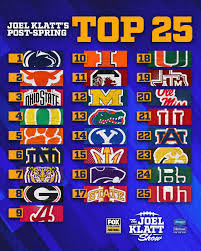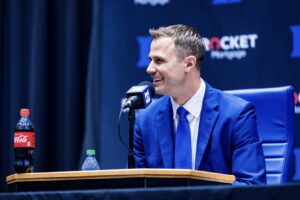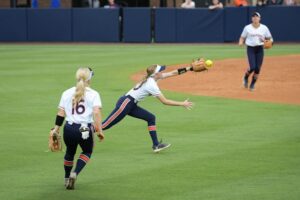
Auburn Football earns Top 25 Spot in Joel Klatt’s Post-spring Rankings.
In the ever-competitive world of college football, rankings are a reflection of both current performance and future potential. For Auburn University, a program that has seen its share of highs and lows in recent seasons, earning a place in Joel Klatt’s Post-Spring Rankings is a significant achievement. Klatt, a well-respected college football analyst known for his keen insight and unbiased perspectives, recently ranked Auburn in the Top 25 of his post-spring rankings. This recognition signals not only a strong spring performance but also the potential for a bounce-back season in 2025.
As we dive into the reasons behind Auburn’s rise in Klatt’s rankings, we will examine the key factors contributing to the Tigers’ resurgence, the impact of their coaching staff, notable players, and the broader implications for the program’s future. This 2000-word analysis will explore Auburn’s performance during the spring, the leadership under head coach Hugh Freeze, and what this ranking could mean for the team’s prospects heading into the fall.
Before we dive into Auburn’s position in Joel Klatt’s rankings, it’s essential to understand the significance of these post-spring rankings. College football teams typically undergo spring practices in April and May, a critical period for building team chemistry, evaluating talent, and refining strategies. Unlike preseason rankings, which are based on past performance, post-spring rankings are an early snapshot of how a team is progressing after the spring practices. These rankings can influence perceptions about a program’s readiness for the upcoming season.
Joel Klatt’s rankings, in particular, are notable for their thoughtfulness and accuracy. A former quarterback at the University of Colorado, Klatt brings a deep understanding of the game, focusing on both Xs and Os and the intangible factors that contribute to a team’s success. His rankings reflect a blend of analysis and foresight, making them an essential tool for evaluating which programs are poised for a breakout season. For Auburn to land in Klatt’s Top 25 speaks volumes about the strides they have made under new leadership.
One of the most significant developments in Auburn football over the past year has been the hiring of Hugh Freeze as the head coach. Freeze, known for his offensive acumen and ability to turn around struggling programs, took over the Tigers’ reins in late 2022, succeeding Bryan Harsin, whose tenure was marred by underperformance and instability. Freeze’s arrival marked the dawn of a new era for Auburn football, one characterized by a renewed sense of optimism and a clear vision for the future.
Freeze’s success at previous stops, particularly at Ole Miss, where he built one of the most potent offenses in the SEC, made him an attractive hire for Auburn. At Ole Miss, Freeze demonstrated an ability to recruit talent, develop quarterbacks, and create a high-octane offense. Under his leadership, the Rebels enjoyed significant success, including victories over top-ranked teams and a consistent presence in bowl games. Auburn’s administration hoped that Freeze could replicate that success and bring stability to a program that had been in flux.
In his first spring at Auburn, Freeze was tasked with evaluating the roster, establishing his culture, and laying the groundwork for future success. The positive changes he has instilled in the program were evident in the spring, leading to the team’s strong performance and ultimately earning a Top 25 spot in Klatt’s rankings. Freeze’s ability to galvanize the team, develop a solid offensive strategy, and improve recruiting has been a driving force behind Auburn’s rise.
During Auburn’s spring practices, there were several signs that the Tigers were heading in the right direction. The team appeared energized and motivated, with players responding well to Freeze’s leadership. While spring football doesn’t always tell the full story, it can offer valuable insights into a team’s readiness and potential for the upcoming season. Auburn’s spring performance showed a team that was focused, well-coached, and hungry to prove itself.
One of the most encouraging aspects of Auburn’s spring was the development of the quarterback position. Under the previous coaching regime, Auburn had struggled to find consistent play at the most important position on the field. However, with Freeze’s background in quarterback development, there was a noticeable improvement in the play of the Tigers’ signal-callers during spring practices.
The competition at quarterback was one of the most closely watched storylines during Auburn’s spring practices. The Tigers entered the offseason with several options at the position, including returning players and new transfers. The standout of the spring was former Michigan quarterback Payton Thorne, who transferred to Auburn after spending three seasons with the Wolverines. Thorne’s experience and familiarity with Freeze’s offensive system made him a natural fit, and he quickly emerged as the leader of the quarterback room. His ability to read defenses, make quick decisions, and push the ball downfield gave Auburn fans reason to be optimistic about the upcoming season.
Additionally, the running back position, which had been a point of strength for Auburn in previous seasons, showed promise with several talented players competing for the starting job. The emergence of young players in both the backfield and the receiving corps indicated that Auburn could have a dynamic offense in 2025, a far cry from the struggles of recent years.
While offense was the primary focus, the defense also showed signs of improvement. Defensive coordinator Ron Roberts, who joined Auburn’s staff under Freeze, has brought a more aggressive approach to the Tigers’ defense. The defense was more disciplined, faster, and played with a renewed sense of urgency during the spring. While Auburn’s defense still faces challenges, particularly in the secondary, the spring showcased a unit that could be more competitive in the SEC.
In order for Auburn to be successful in 2025, the Tigers will need key players to step up and make an impact. While the team has some holes to fill, there are several individuals who have the potential to shine.
-
Payton Thorne (Quarterback) – As mentioned, Thorne has the potential to be the catalyst for Auburn’s offense in 2025. If he can build on his solid spring performance and continue to improve, he could become one of the top quarterbacks in the SEC. His ability to connect with his receivers and manage the game will be crucial for Auburn’s success.
-
Jarquez Hunter (Running Back) – Hunter is one of Auburn’s most talented playmakers and has the potential to be one of the best running backs in the SEC. He showed flashes of brilliance last season, and with a more developed offensive scheme under Freeze, he could be poised for a breakout year.
-
Camden Brown (Wide Receiver) – Brown is one of the top receivers for Auburn and was a standout during the spring. With an improved passing game, Brown could be a key weapon for the Tigers in 2025, providing a reliable target for Thorne.
-
Colby Wooden (Defensive Line) – Wooden has been a steady contributor on the defensive line and will be an important part of Auburn’s defensive efforts in 2025. His ability to disrupt the opposing quarterback and stop the run will be critical to Auburn’s success.
-
Eugene Asante (Linebacker) – Asante has the potential to be a leader on defense, and his performance in the spring was encouraging. With his athleticism and leadership skills, Asante could be one of the SEC’s top linebackers in 2025.
One of the major factors behind Auburn’s rise in the rankings is the recruiting success that Freeze and his staff have enjoyed. In his short time at Auburn, Freeze has already secured several key commitments and built relationships with top-tier high school recruits. Auburn’s recruiting class for 2025 has the potential to be one of the best in the SEC, and this influx of talent will only bolster the team’s prospects moving forward.
The Tigers’ recruiting efforts, combined with Freeze’s track record of developing talent, position Auburn to be a contender in the SEC once again. While the team may still face some growing pains in the first few years under Freeze, the foundation is being laid for sustained success.
Earning a spot in Joel Klatt’s Post-Spring Rankings is a testament to Auburn’s progress under Hugh Freeze’s leadership. The Tigers have made significant strides since the arrival of their new head coach, and the spring practices showcased a team with renewed energy, improved fundamentals, and the potential for success. With key players emerging, a more cohesive offensive and defensive strategy, and a promising recruiting pipeline, Auburn’s future looks bright.





